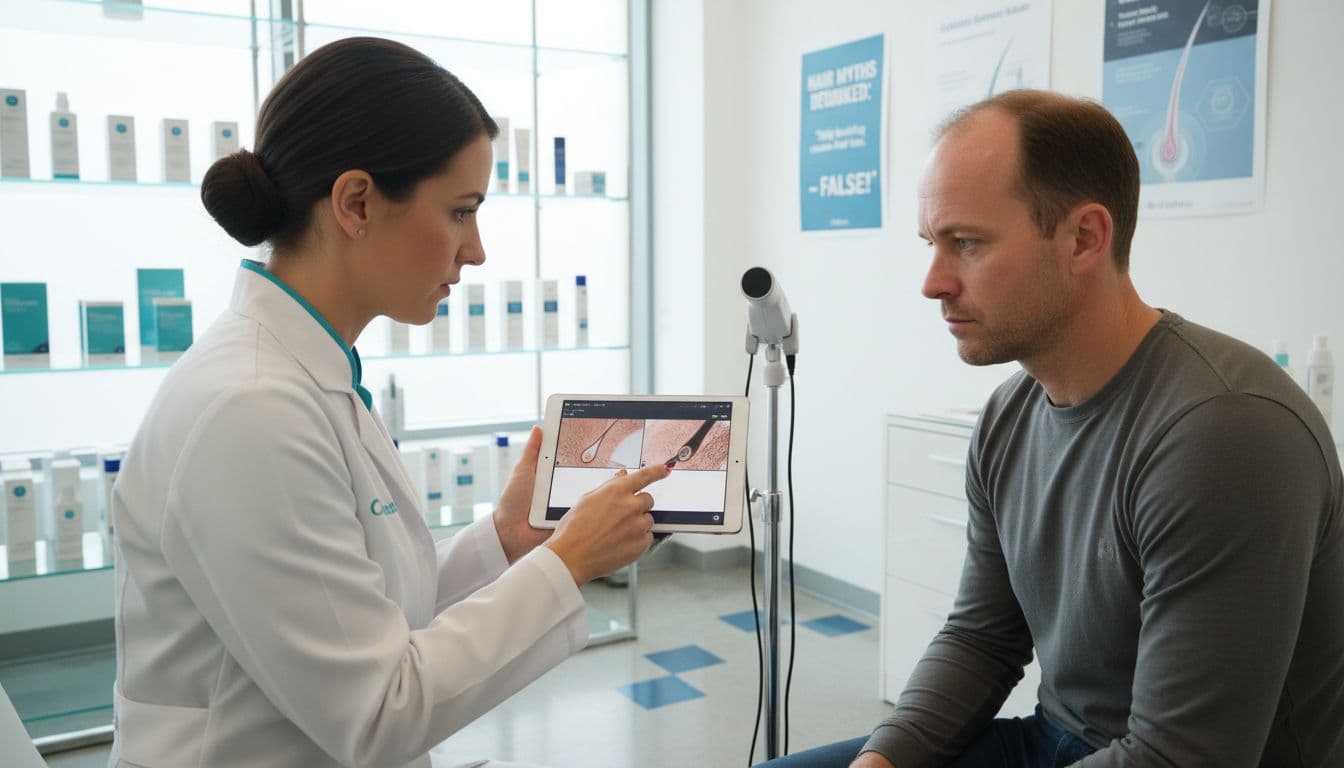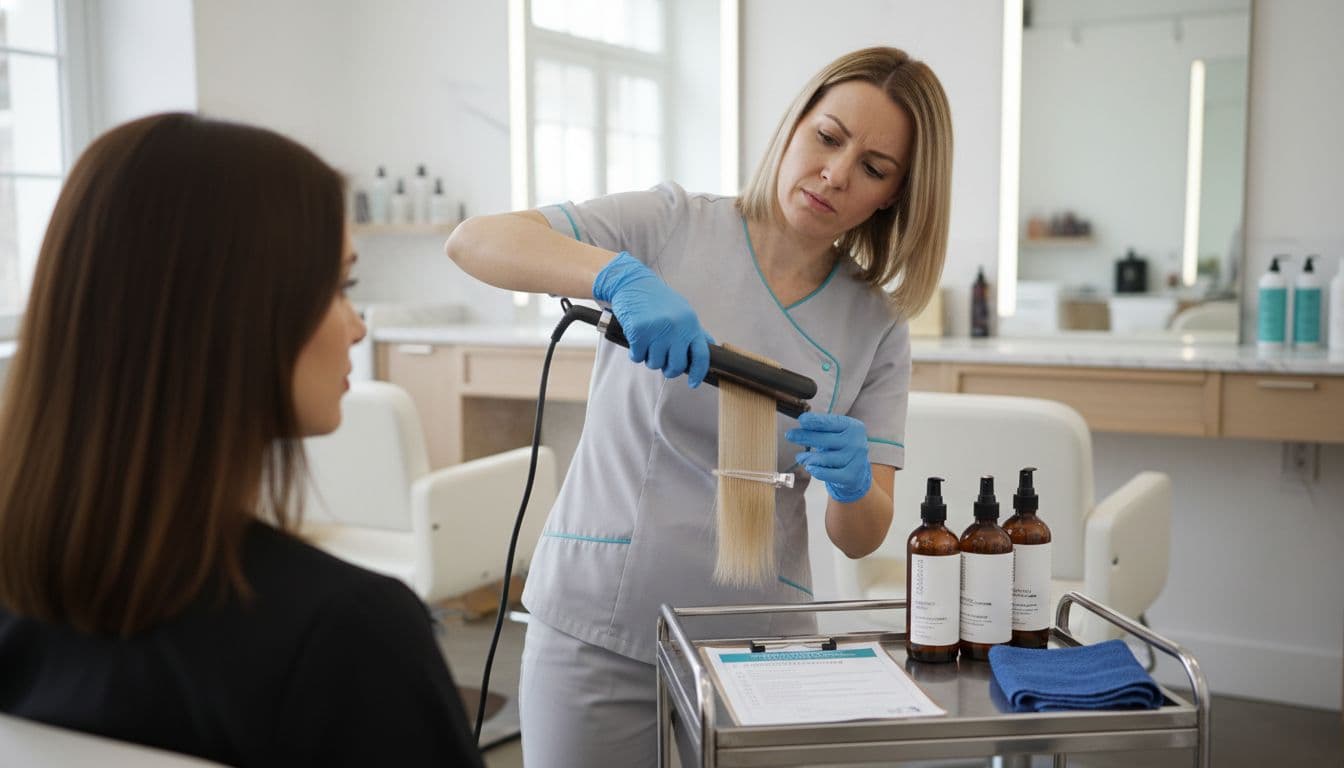Blog
Learning Materials
Hair Treatment Explained: Methods, Risks, and Results
Updated: November 16, 2025

More than half of adults believe myths about hair treatments, even though science shows many of these ideas are wrong. Misunderstandings about what works and what causes hair loss can lead to wasted time and frustration. Learning the truth about hair treatments matters because it helps people make better choices for healthier hair and real results. This guide breaks down facts versus fiction so you can care for your hair with confidence.
Table of Contents
- Defining Hair Treatment And Common Myths
- Types Of Hair Treatments And Their Purposes
- How Professional And At-Home Treatments Work
- Personalization Through Ai And Technology
- Risks, Side Effects, And Safety Tips
- Comparing Popular Hair Treatment Alternatives
Key Takeaways
| Point | Details |
|---|---|
| Understanding Myths is Crucial | Awareness of common hair treatment myths can help individuals make informed decisions and develop effective hair care strategies. |
| Personalization is Key | Tailoring treatments to individual hair characteristics and health conditions is essential for achieving desired results. |
| Professional Guidance Recommended | Consulting with professionals ensures safer application of treatments and minimizes potential risks associated with chemical processes. |
| Emerging Technologies Enhance Treatment | Advances in AI and technology offer personalized hair treatment insights, improving effectiveness in addressing specific hair concerns. |
Defining Hair Treatment and Common Myths
Hair treatment represents a comprehensive approach to addressing hair health challenges, ranging from structural damage to growth concerns. At its core, hair treatment involves targeted interventions designed to restore, protect, and enhance hair's natural condition. According to research from PubMed, numerous misconceptions persist about hair loss and treatment effectiveness, making understanding these interventions critical.
Common myths about hair treatments often stem from misinformation and oversimplified understanding of hair biology. The Journal of Dermatology Online highlights several prevalent misconceptions, particularly around treatments like minoxidil and natural remedy efficacy. These myths typically fall into several categories:
- Myth 1: All hair treatments work universally for everyone
- Myth 2: Natural remedies are always safer and more effective than clinical treatments
- Myth 3: Hair loss is solely determined by genetics
- Myth 4: One treatment will permanently solve all hair problems
Understanding hair treatment requires recognizing its multifaceted nature. It's not just about applying products, but comprehending individual hair characteristics, underlying health conditions, and personalized care strategies. Understanding Hair Damage Types: A Complete Guide can provide deeper insights into how different treatments address specific hair concerns.
Proper hair treatment involves scientific assessment, targeted interventions, and ongoing maintenance. It's a nuanced process that goes beyond quick fixes, requiring patience, consistent care, and sometimes professional guidance. By dispelling myths and embracing evidence-based approaches, individuals can develop more effective strategies for maintaining healthy, vibrant hair.
Types of Hair Treatments and Their Purposes
Hair treatments encompass a wide range of techniques designed to address specific hair concerns, from structural damage to growth challenges. Understanding these treatments requires recognizing the unique purposes and methodologies behind each approach. Understanding Treatment for Over Processed Hair highlights the complexity of selecting the right intervention for individual hair needs.
Chemical treatments represent a significant category of hair interventions. According to research, hair relaxers are chemical processes that fundamentally alter hair structure. As Wikipedia explains, these treatments break down the hair's natural structure, making extremely curly hair more manageable. Other chemical treatments include:
- Keratin Treatments: Smoothing and reducing frizz
- Perms: Changing hair texture and creating permanent waves
- Color Treatments: Altering hair pigmentation
- Bleaching: Lightening hair color
Advanced medical treatments offer more sophisticated hair restoration options. Platelet-rich plasma (PRP) therapy has emerged as a promising intervention for hair loss. Wikipedia indicates that PRP can effectively treat conditions like alopecia areata and androgenetic alopecia, improving hair density and thickness for both men and women.
Modern hair treatments go beyond simple cosmetic interventions. They represent complex scientific approaches that address underlying hair health issues. Damaged Hair Care Guide emphasizes the importance of personalized treatment strategies that consider individual hair texture, health conditions, and specific restoration goals. Whether addressing structural damage, promoting growth, or enhancing aesthetic appearance, contemporary hair treatments offer targeted solutions for diverse hair challenges.

How Professional and At-Home Treatments Work
Hair treatments can be broadly categorized into professional salon services and at-home interventions, each offering unique approaches to hair care and restoration. While professional treatments provide advanced, specialized techniques, at-home solutions offer convenience and accessibility. 7 Recommended Hair Loss Treatment Strategies highlights the importance of understanding these different treatment modalities.
Professional treatments often involve complex chemical processes that require specialized expertise. Brazilian hair straightening, for instance, is a sophisticated technique that Wikipedia describes as a semi-permanent method using formaldehyde-based solutions sealed into hair with heat. Similarly, perms represent another intricate professional treatment. As Wikipedia explains, perms involve applying chemicals to hair and wrapping it around specialized forms to create lasting waves or curls that can persist for several months.
At-home treatments typically focus on more accessible, user-friendly approaches. These can include:
- Deep conditioning masks
- Leave-in treatments
- Hair repair serums
- Protein-based reconstructive products
The key difference between professional and at-home treatments lies in technique complexity, application precision, and long-term results. Professional treatments often provide more dramatic transformations but require expert application, while at-home treatments offer gradual improvements with lower risk. Best Hair Mask for Hair Growth at Home demonstrates how targeted at-home solutions can effectively support hair health.
Successful hair treatment ultimately depends on understanding individual hair needs, selecting appropriate interventions, and maintaining consistent care.
Whether choosing professional services or at-home solutions, the goal remains the same: restoring hair's health, strength, and aesthetic appeal through scientifically informed and personalized approaches.
Personalization Through AI and Technology
Artificial intelligence and advanced technological approaches are revolutionizing hair treatment by offering unprecedented levels of personalization and precision. Best New Hair Growth Treatment Options highlights how technology is transforming our understanding of individual hair care needs.
Cutting-edge research is pushing the boundaries of hair analysis and treatment. A groundbreaking study from ArXiv introduced a remarkable robotic system capable of automatically adjusting front hairstyles using advanced path planning techniques for root-centric strand manipulation. This represents a significant leap in precision hair styling, demonstrating how technology can offer microscopic control over hair treatment.
Advanced AI modeling is transforming hair visualization and treatment strategies. Neural hair modeling has emerged as a sophisticated approach, with research like the NeuralHDHair system demonstrating the ability to create high-fidelity 3D hair models from a single image. This technology enables unprecedented personalization by allowing detailed analysis of:
- Individual hair strand characteristics
- Precise growth pattern mapping
- Predictive hair health assessments
- Customized treatment recommendations
Technological innovations are making hair treatments more accessible and tailored than ever before. Hair and Skin Care: Expert Tips illustrates how AI-driven approaches can provide insights that were previously impossible. By combining machine learning, advanced imaging, and sophisticated algorithmic analysis, modern hair treatments can now offer truly personalized solutions that adapt to each individual's unique hair profile and health requirements.
Risks, Side Effects, and Safety Tips
Hair treatments, while offering transformative results, come with potential risks that demand careful consideration and informed decision-making. Understanding these potential complications is crucial for maintaining long-term hair and scalp health. Latest Hair Treatment 2025: Advanced Solutions emphasizes the importance of comprehensive risk assessment before any hair intervention.
Chemical treatments represent one of the most significant areas of potential health concern. Wikipedia reveals that some treatments, like Brazilian hair straightening, often contain formaldehyde - a known health hazard that has led to bans in multiple countries due to serious safety implications. Similarly, Wikipedia highlights that hair relaxers can potentially weaken hair structure, leading to:
- Brittleness
- Increased breakage
- Potential hair loss (alopecia)
- Scalp irritation
To mitigate these risks, individuals should consider several critical safety strategies:
- Always conduct a patch test before full treatment
- Consult with professional hair specialists
- Use treatments from reputable, certified providers
- Follow manufacturer instructions precisely
- Monitor your hair and scalp for adverse reactions
Personal vigilance and professional guidance are essential in navigating potential treatment risks. Hair and Skin Care: Expert Tips recommends comprehensive research and professional consultation to ensure safe, effective hair treatment experiences. By understanding potential side effects and implementing proactive safety measures, individuals can minimize risks while achieving desired hair transformation goals.
Comparing Popular Hair Treatment Alternatives
Navigating the landscape of hair treatments requires understanding the diverse range of options available, each with unique benefits and approaches. Protein Treatment for Natural Hair illustrates the complexity of selecting the most appropriate intervention for individual hair needs.
Platelet-rich plasma (PRP) has emerged as a promising alternative to traditional hair loss treatments. According to Wikipedia, studies have reported PRP as a beneficial approach for addressing alopecia areata and androgenetic alopecia, offering a compelling alternative to conventional medications like minoxidil or finasteride. This treatment involves:
- Extracting patient's own blood
- Concentrating platelet components
- Injecting specialized plasma into scalp regions
- Stimulating natural hair growth mechanisms
Alternative light-based treatments provide another innovative approach. Wikipedia highlights intense pulsed light (IPL) as a distinctive hair reduction technique, particularly effective for darker, coarser hair. Unlike laser hair removal, IPL uses broad-spectrum light to target hair follicles, offering a different mechanism of intervention.
Choosing between treatment alternatives requires careful consideration of individual hair characteristics, growth patterns, and specific concerns. Black Hair Treatment for Growth emphasizes the importance of personalized assessment, ensuring that selected treatments align with unique hair and scalp conditions. Ultimately, the most effective approach combines scientific understanding, professional consultation, and tailored strategies that address specific hair health goals.
![]()
Discover Personalized Solutions for Your Hair Treatment Journey
If you are struggling with understanding the best methods to restore your hair health or worried about the risks involved in chemical and medical treatments mentioned in the article, you are not alone. Many people seek effective ways to manage hair loss, damaged hair, or thinning without falling for common myths. With AI-based hair health analysis and personalized care strategies, you can move beyond guesswork and embrace a treatment plan tailored just for you.

Start your journey today by visiting MyHair.ai where advanced algorithms analyze your hair condition using easy scan uploads. Gain deep insights into your unique hair profile and receive Personalized growth projections and Tailored product recommendations designed specifically to improve your hair’s strength and vitality. Don’t wait for further damage or uncertainty. Take control of your hair health now with a scientifically informed and user-friendly approach available anytime at MyHair.ai.
Frequently Asked Questions
What are the most common types of hair treatments?
Hair treatments can include chemical treatments like hair relaxers, keratin treatments, perms, and color treatments, as well as advanced medical options like platelet-rich plasma (PRP) therapy, which promotes hair growth.
How do at-home hair treatments differ from professional services?
At-home treatments are generally more accessible and include products like deep conditioning masks and leave-in treatments, while professional services involve more complex applications and techniques, yielding more dramatic results.
What are the risks associated with chemical hair treatments?
Chemical treatments can lead to risks such as brittleness, increased breakage, scalp irritation, and potential hair loss. It's essential to follow safety protocols and consult professionals to minimize these risks.
How is personalization achieved in hair treatments?
Personalization in hair treatments is achieved through advanced technology like AI, which analyzes individual hair characteristics and recommends tailored treatment strategies based on specific health requirements and hair types.
Recommended
- Understanding Treatment for Over Processed Hair: Key Insights | MyHair
- Achieve Sleek Hair with Natural Hair Straightening Treatment | MyHair
- Understanding Hair Damage Types: A Complete Guide | MyHair
- Best Protein Treatment for Natural Hair in 2025: Growth & Care | MyHair
- Protecting Hair From Heat: The Essential Guide - Joel C Ma Hair Studio